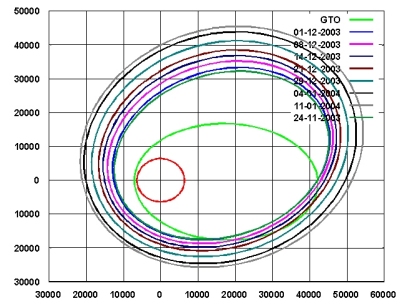No.15 - Preparing for the payload commissioning
Starting from early February the ion engine will not be used to generate thrust for a period of three weeks. This phase of the mission will be used to perform the scientific instrument commissioning. A series of observations of celestial targets with different instruments is being prepared and will be described in a future report.
Another milestone was reached this week: the mission commissioning results review was held at ESOC. This review was planned to be held as soon as the first mission phase, the exit of the radiation belts, was completed. The results of the on-orbit verification of all the spacecraft subsystems were presented. All the subsystems have now been verified. However, some spacecraft functions have yet to be tested. This is because some are triggered by a failure scenario and others have not yet been needed.
A plan has been prepared to solve the few anomalies that are still affecting the spacecraft's smooth operations. These include a software function to autonomously re-start the electric propulsion engine after an unexpected shutdown, a proper strategy to improve the performance of the star tracker that is affected by the combined effects of high temperature and radiation induced degradation, and a proper strategy to circumvent the occasional failures of the telemetry Reed-Solomon coding checksum. Updates on the progress being made will be posted in future status reports.
Orbital/Trajectory information
The osculating orbital elements are periodically computed by the ESOC specialists. These elements define the so called "osculating orbit" which would be travelled by the spacecraft if at that instant all perturbations, including EP thrust, would cease. So it is an image of the situation at that epoch. In reality the path travelled by the spacecraft is a continuous spiral leading from one orbit to another. The most recent osculating elements are as follows:
|
EPOCH (UTC) 2004/01/11 16:18:33.5 Elements WRT Earth (J2000) |
|
| Pericentre Distance (km) |
20 107.697351 |
| Apocentre Distance (km) |
58 363.288771 |
| Semi Major Axis (km) |
39 235.493061 |
| Eccentricity |
0.487513 |
| Inclination (deg) |
6.876771 |
| Asc. Node (deg) |
150.679570 |
| Arg. of Pericentre (deg) |
211.174542 |
| True Anomaly (deg) |
180.280612 |
| Osc. Orbital Period (h) |
21.484594 |
 |
|
SMART-1 osculating orbit up to 11 January 2004 |
Contact Point
Giuseppe Racca
SMART-1 Project Manager
ESA/ESTEC - SCI-PD
Keplerlaan 1- 2200 AG Noordwijk, The Netherlands
E-mail: Giuseppe.Racca esa.int
esa.int

